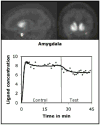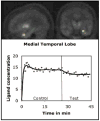Dopamine release during human emotional processing
- PMID: 19524047
- PMCID: PMC2740985
- DOI: 10.1016/j.neuroimage.2009.06.008
Dopamine release during human emotional processing
Abstract
Involvement of dopamine neurotransmission in human emotional processing is unclear but animal studies have indicated that it is critical for processing of fear response. In this experiment we examined dopaminergic involvement in the processing of human emotions. We used a novel dynamic molecular imaging technique to detect and map dopamine released during presentation of emotional stimuli. The technique exploited the competition between endogenously released dopamine and its ligand for receptor occupancy and involved dynamic voxel-wise measurement of the rate at which a dopamine receptor ligand ((18)F-Fallypride) was displaced from receptor sites during emotional processing. An increase in the rate indicated dopamine release. We found that the rate of ligand displacement increased significantly in the left amygdala, left medial temporal lobe (MTL) and left inferior frontal gyrus. The results provide the first direct evidence of dopaminergic modulation of human emotional processing and suggest that the modulation occurs at multiple levels of processing. This finding indicates that the neurocognitive models of human emotion should take into account dopaminergic effects, and that, there is a need to investigate whether manipulation of the dopaminergic system could be an alternate strategy for treatment of conditions in which emotional processing is impaired.
Figures




References
-
- Alpert NM, Badgaiyan RD, Livini E, Fischman AJ. A novel method for noninvasive detection of neuromodulatory changes in specific neurotransmitter systems. NeuroImage. 2003;19:1049–1060. - PubMed
-
- Badgaiyan RD, Fischman AJ, Alpert NM. Striatal dopamine release during unrewarded motor task in human volunteers. Neuroreport. 2003;14:1421–1424. - PubMed
-
- Badgaiyan RD, Fischman AJ, Alpert NM. Explicit Motor Memory Activates the Striatal Dopamine System. NeuroReport. 2008;19:409–412. - PubMed
-
- Blackburn JR, Phillips AG. Enhancement of freezing behaviour by metoclopramide: implications for neuroleptic-induced avoidance deficits. Pharmacol Biochem Behav. 1990;35:685–691. - PubMed
Publication types
MeSH terms
Substances
Grants and funding
LinkOut - more resources
Full Text Sources

